There’s more to gaming life than the endless core gameplay loop of rulebook missions and ITC events! In the Narrative forge, we explore Narrative Play, looking for ways to tell stories on the tabletop and enhance play experiences by creating narratives and weaving story elements into your games.
Almost two years ago, I wrapped up my final 7th edition campaign and my group started running a new campaign: The Astradus campaign, a multi-state, escalation mass campaign incorporating nearly 30 players across the U.S. Northeast coast. I’ve talked about it before – check out this link for more info. Something I briefly touched on back in that article was that one of the major things I wanted to do in the campaign was have players design their own warlords using the custom character creation rules from Chapter Approved 2018. They were brand new at the time and seemed like a really cool way to encourage players to do custom conversions and create some backstories.
The Rules for Warmasters
I started players off by having them create a single custom Warmaster to lead their armies. Players had to follow these rules when creating a Warmaster:
- A Warmaster could be any CHARACTER with the HQ designation.
- Players build their warmaster by selecting 4 traits from the Custom Character tables in Chapter Approved 2018, and could come up with their own if they really wanted, but these would have to be approved by me, the campaign GM. More on that in a bit.
- Players had to choose a Warlord trait for their warmaster. This couldn’t change, and if they included their Warmaster in their army, that character would have to be their warlord.
- Likewise, they could give their warmaster a relic, but this would count as their army’s free relic and couldn’t change.
- Warmasters cost +25 points over the model they replaced.
- If a player killed a Warmaster in battle, they’d score 1 Campaign Victory point. A player could only score 1 point for killing a given warmaster kill each round.
- Warmasters couldn’t die under normal circumstances, but in some situations (see below), they can die permanently and be replaced.
- Once a Warmaster was complete, players had to submit them for approval along with a photo of the model and their backstory.
This last step ended up being super important – there are a number of rules in the character creation rules that can cause real problems in a game of 40k and while our campaign group is, for the most part casual, there were definitely some real potential “feel bad” moments waiting to happen. The first piece of advice I have is: Remove or disallow the ability that lets characters target an enemy CHARACTER even if it isn’t the closest. I got half a dozen submissions that all had that rule on them, ready to pop in and murder the other player’s warmaster immediately and ruin the whole thing – what good are warmasters if they just die right away? So, I had to nix almost all of these, though the worst were a Crisis Suit Commander with 4 fusion blasters and a Big Mek with Shokk Attack Gun.
In some cases, I worked with players to help create custom characters that had unique abilities or rules. Often these reflected the character’s backstory in interesting ways.
Building a Narrative
Each player in the campaign was asked to build a backstory for their character, a small creative writing assignment of sorts. I ended up helping some of the players with this, while others handed in eight-page short stories that I had to trim down!
My Warmaster was named Kaervek Urrakis. He’s notable because the rules I decided to give him evolved from the story we’d created around him over the course of the prior campaign.
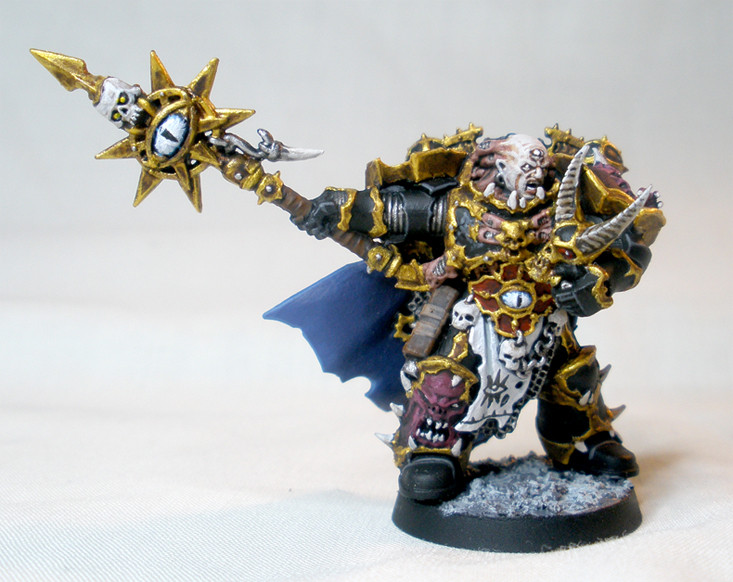
Kaervek started life as a Black Legion sorcerer in the campaign army I used in my Paulus campaign, a 7th edition linear narrative campaign I started with three other friends that saw our forces squaring off every couple of weeks until the campaign grew to 8 players and ended in a large game of Apocalypse. That megabattle saw the Black Legion forces ultimately triumphant as Kaervek completed a ritual that flooded the planet with daemons and led to its conquest.
During that campaign, my army was led by the Chaos Lord Molloch, a powerful lord who was ultimately killed in battle by the T’au Commander Kin’Shi. I made his model from the Chosen champion in the Dark Vengeance boxed set, replacing the end of his mace with the staff head from the Chaos Terminator Sorcerer Lord, and I painted his cloak blue to show his allegiance to the Sons of the Cyclops warband, who are dedicated to Tzeentch.
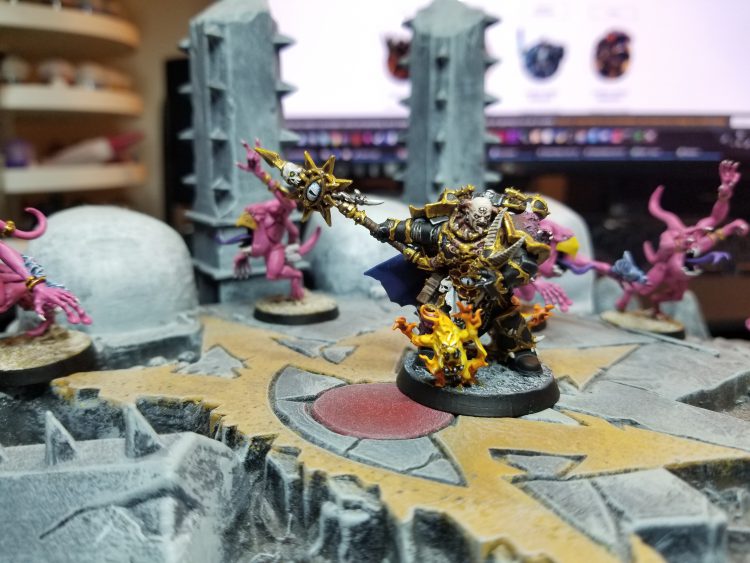
When I started the Astradus Campaign, I wanted to keep using my Black Legion and felt it was worth it to continue the story of Kaervek (a couple of other characters were returning for my friends’ armies as well). I knew I needed to re-base him to get him on a 32mm base (of course, GW then released a sorcerer on a 40mm base), and when I did so wanted to signify that he’d become a powerful summoner, so I added a pair of brimstone horrors to his base. At that point I decided he’d be a former Word Bearers sorcerer, which would fit well with his knowledge of Daemonology.
Rules-wise, I gave him an invulnerable save, reasoning that he’d taken Molloch’s Sigil of Corruption (this was also just something vitally important for a warmaster to have), plus an extra Wound, the Foresight ability to reflect his third eye mutation, and an aura helping summon Daemons to reflect his mastery of those dark arts.
Check out Kaervek’s Datasheet and Backstory Here
More Astradus Warmasters
Kaervek wasn’t the only Warmaster in the campaign. Several other players are Goonhammer authors. I asked Necromunday author Merton and Hammer of Mathauthor “Primaris” Kevin to talk about their warmasters and how they were made.
Merton’s Warmaster: Grubslag
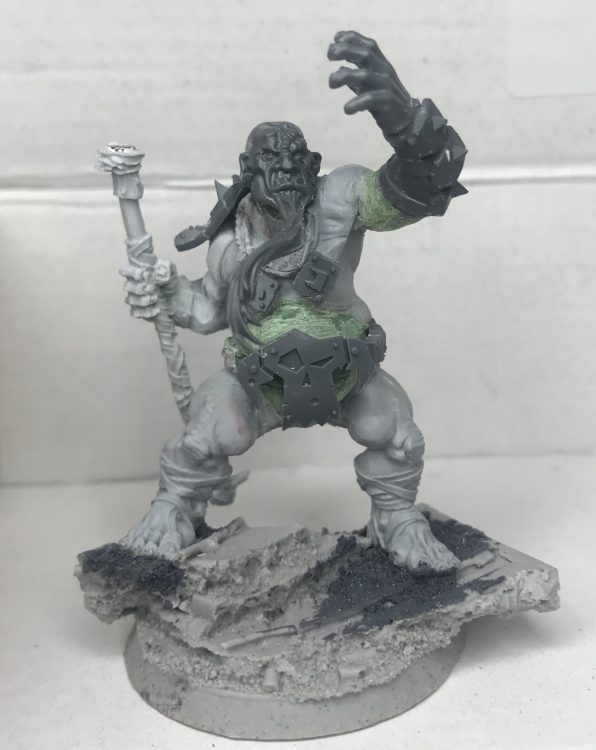
Merton: Grubslag wasn’t always supposed to be my Warlord, he just turned out to be the biggest and took over! I already had a Gorkamorkish Digganob Kill Team made out of Ogryns, filed-down Poxwalkers, and various Orky bits, and was looking to expand into a full army. I had all sorts of grandiose plans for a kitbashed proper Warboss, but started on my Weirdboy first and heavily underestimated the size of the Ogre Firebelly I had ordered to be the base model. As soon as I saw him, towering heads above everyone else, I realized that he was destined to be in charge.
Click here to see the final datasheet for Grubslag
Rules-wise, Grubslag is a beefed-up Weirdboy, following Merton’s theme of making a Digganobz army.
Kevin’s Warmaster: Watch Master Ominus
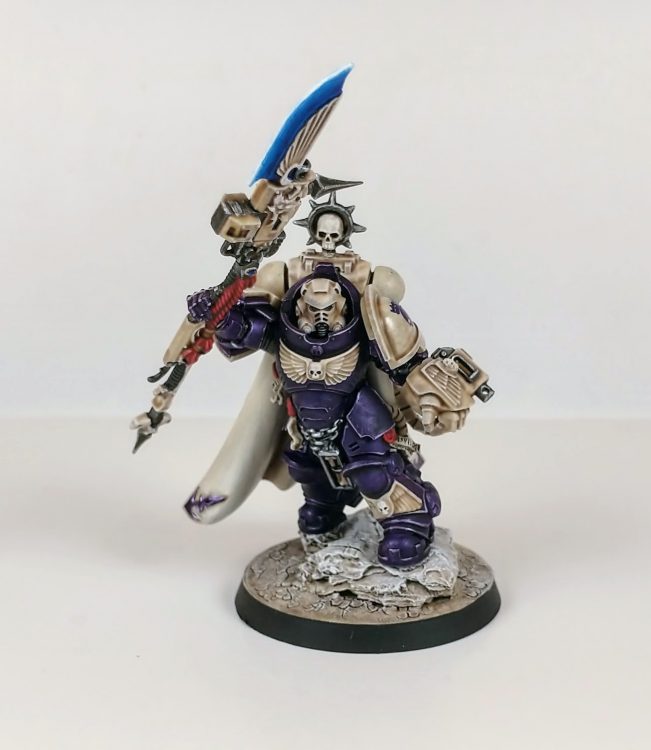
Kevin: When I put together the Regal Skulls the Deathwatch were by far the best option for an exclusively Primaris force. With that in mind I wanted to do something special, so I fit a Custodes Guardian Spear to a Captain in Gravis Armor and made a Primaris Watch Master. Normally I just use the regular Watch Master rules, but with the custom character generation options offered in the Astradus Campaign it was fun to add to stats to make a true Watch Master who had crossed the Rubicon Primaris. The four options gave him an added wound, toughness, attack, and the option for a Guardian Spear. This also gave me a chance to explore why a Primaris Astartes force would be using the configuration of a Deatwatch force, and that led to the lore applied to the campaign book. For the name “Watch Master Ominus” I summoned my inner twelve year old and channeled the spirit of Inquisitor Obiwan Sherlock Clousseau for inspiration.
Click here to see the final datasheet for Ominus
Rules-wise, Ominus is literally a beefed-up Primaris Captain who, as one of his traits, has a Custodes spear.
Handling Warmaster Death: The Ballad of Barbatos

Greg “Greg” Chiasson’s warmaster entry was Interrogator-Chaplain Barbatos, a veteran of several wars whose backstory was linked to our 7th edition campaign, a map-based event that I ran with a smaller group of friends that ended in an apocalyptic battle with an invading hive fleet. Barbatos was a stern individual known for refusing to admit fault and doubling down on his mistakes. Rules-wise, Barbatos had three abilities and his fourth was a custom relic – the Passive Aggressor, a combi-plasma with the benefit that it uh, wouldn’t kill the owner if it overheated. This is important because Greg overcharges his plasma guns 100% of the time. I’ve mentioned it before, but Greg loses a lot of games. Like all of them. All of the games. He quickly fell to the bottom of our campaign standings with Barbatos. Part of this was that the Dark Angels had awful rules. And part of it was just Greg.
About midway through last year, Greg finally painted his warhound titan, and so to celebrate and give him an excuse to run it, I created a custom campaign mission designed to model Barbatos receiving a requisitioned titan for his forces, only to come up against Ork forces trying to smash it and steal its powerful gubbins. This mission ended up being a 2-vs-1 where Barbatos’ goal was to get the Warhound through a gauntlet of orks, while the Orks were attempting to bring it down and, if they succeeded, would then fight each other over the spoils.
You can find that mission here.
Note that if I were to run this again, I’d drop the ork forces down to something more like 500-750 points each, since last time the Warhound didn’t last a single turn. Story-wise, this ended up being pretty hilarious, with the Legio Titanicus and the Mechanicus refusing to send Barbatos more support.
As the campaign wore on, Greg became less interested in running Barbatos, who wasn’t very good, and asked me if he could run a new warmaster. I told him yes but it had to be a chaplain dreadnought of Barbatos. So the next time Barbatos died (which turned out to be immediately in the following campaign game), we made his death permanent and replaced him with Venerable Dreadnough Chaplain Barbatos. Rules-wise, this meant keeping Barbatos’ aura abilities but swapping out his custom combi plasma gun, The Passive Aggressor, for something else.
Click here to see Barbatos’ Datasheet
Well it turns out Chaplain Barbatos was just as ornery and worthless as old fleshy Barbatos, and exploded in his first game after not doing much of anything, killing a bunch of Greg’s models when it did. Just wonderful stuff.
When the new Dark Angels models for Horus Heresy Dark Angels came out, Jack “BenBooley” Hunter wanted an excuse to paint one of them for How to Paint Everything: Dark Angels. Once he was finished, he had no need for the model and decided to send it to Greg. So we collaborated on a new, better warmaster – a contemporary of Barbatos who, unlike the chaplain, was highly-regarded and well-liked by his peers. Meet Master Gallagim <None> (hey it’s GW’s name generator). Rules-wise, Gagallim’s a sight tougher than Barbatos, giving Greg a warmaster with more staying power.
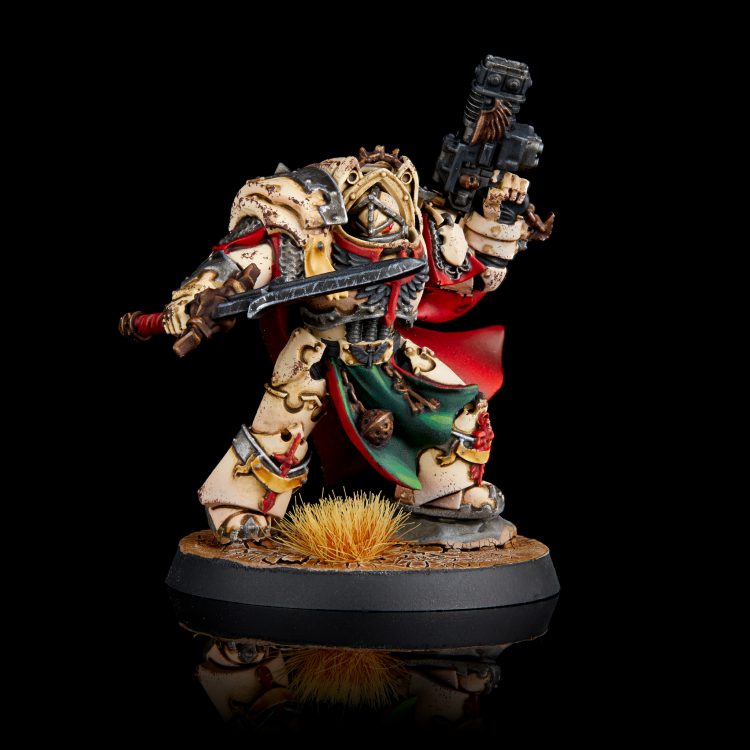
Creating Custom Character Rules
There were several times during the campaign when I helped other players create special rules for their own custom Warmasters, either by request – “hey I’ve got this cool model idea, can you help me make it work” – or because we were having trouble creating something that wasn’t a character-targeting-murdermachine. My friend Ethan’s Tau Crisis Suit Commander was one of those warlords and we worked together to build a special rule that fit his backstory. Like Kaervek, Kin’Shi was a participant in the prior campaign, and by some accounts the winning general (Ethan had the lead on campaign victory points but lost the mega battle to end the campaign). To reflect this, Ethan gave Kin’Shi a backstory that reflected his final misstep and how that led to the death of his Ethereal and his exit from the empire. Ethan had already converted an army of Gue’vesa fire warriors, imagining his T’au as pirates, and he made the first campaign his prequel backstory for his warmaster. Now, freed of the T’au Empire’s influence, Kin’Shi’s T’au had teamed up with a particularly corporate human planetary governor, and acted as pirates and raiders, stealing technology and supplies.
Crisis suits had been pretty bad for a while and Ethan wanted a reason to run them, so we created a rule that Kin’Shi could, for 1 CP, upgrade a squad of Crisis Suits to have Coldstar engines, allowing them to blast around and keep up with Kin’Shi. This made them significantly more mobile and also able to protect the commander while also reflecting the idea that they’d gotten custom tech on their suits. To represent Kin’Shi winning the prior campaign, he was the only warmaster with 5 traits – the last one being that he gives +1 Command Point if he’s your warlord (this essentially can make the upgrade “free”).
Other Warmasters
If you’re interested in meeting some of the other Warmasters, I’ve included a few links below to others made by Goonhammer contributors/authors. Rules-wise, these run the gamut from “just picked four traits” to “I have a completely wild custom idea in mind” in the case of Col. Viers.
Shadow Captain Lanius by Dan “SexCannon” Boyd
Jago Lytanus by Jack “BenBooley” Hunter
Skug Scrunterssen by BuffaloChicken
Col. Mathias Viers by Scott Horras “Heresy”
Shield-Captain Caracalla Tarautas by Evan “Felime” Siefring
Next Week: More on Custom Characters
Well that does it for this week, but if you want to read more about creating custom characters, check back in next week when Charlie Brassly will talk in more detail about creating the stories that inform characters and representing those on the tabletop. In the meantime, if you have any questions or feedback, drop us a note in the comments below or shoot us an email at contact@goonhammer.com.


